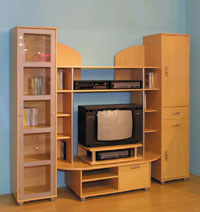Housewares & Miscellaneous Items
2. Home entertainment - TV and HiFi
|
MDF is often used for the manufacture of television and hifi cabinets, loudspeaker boxes and the base and wall units purpose designed for housing this equipment. The surfaces can be wood veneered, covered with decorative foil or painted. |
 |
Cabinets with rectangular corners are formed from strips of PVC surfaced MDF premachined with mitre grooves cutting through the MDF leaving the foil intact. The PVC acts as a hinge at each corner of the box. The joints are secured by applying a bead of adhesive along each mitre face, hot melt adhesive for quick assembly or polyvinyl acetate (PVAC) if a longer setting time is acceptable. Cabinets with rounded corners can be manufactured using conventional dowel or tongue jointing to form square edge cabinets which can be machined with rounded corners. Paper or PVC foil can then be wrapped round the cabinet to provide the decorative finish.
Alternatively, the rounded corners can be developed as part of the grooving and folding process using shaped inserts cut from cork or other conformable material to support the PVC round the corner.
MDF can be used to good effect for the front masks of television cabinets as the intricate machining operations required for the tube cut out, loudspeaker grille and controls can be carried out without the risk of torn grain, chipped corners or breakout. The smooth surfaces and clean cut edges of MDF masks can be painted to contrast with a wood grain wrapped carcase. The decorative effect can be enhanced by screen printing.
The sound quality of loudspeakers is enhanced by enclosing them in MDF cabinets. The fibrous structure of the MDF absorbs unwanted sound waves emanating from the back of the speaker cones, thereby reducing distortion. The high density of MDF compared with most other wood based sheet materials reduces the amount of sound energy transmitted through the walls of the cabinet so that only the direct sound from the cones reaches the listener.
The increasing number of boxes required for a complete home entertainment kit are normally displayed in a purpose built cabinet with back access for wiring and storage for discs and tapes. MDF cabinets, finished by wood veneering, painting or foiling have the right appearance to complement the sophisticated electrical equipment.












